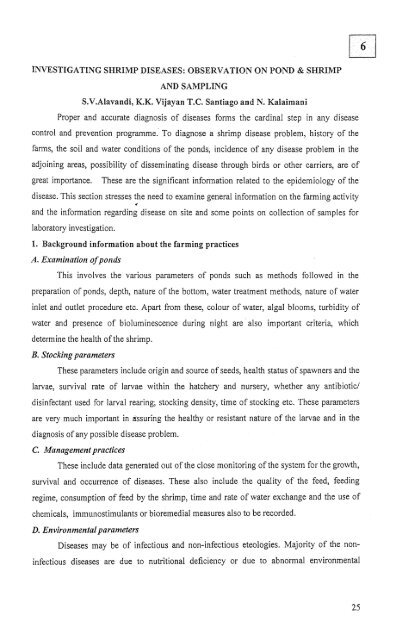, Diagnosis an-&& of Shrimp Diseases - Central Institute of ...
, Diagnosis an-&& of Shrimp Diseases - Central Institute of ...
, Diagnosis an-&& of Shrimp Diseases - Central Institute of ...
- No tags were found...
You also want an ePaper? Increase the reach of your titles
YUMPU automatically turns print PDFs into web optimized ePapers that Google loves.
INVESTIGATING SHRIMP DISEASES: OBSEliVATION ON POhZ) gL SHRIMPAND SAMPLINGS.V.Alav<strong>an</strong>di, K.K. Vijay<strong>an</strong> T.C. S<strong>an</strong>tiago <strong>an</strong>d N. Kalaim<strong>an</strong>iProper <strong>an</strong>d accurate diagnosis <strong>of</strong> diseases forms the cardinal step in <strong>an</strong>y diseasecontrol <strong>an</strong>d prevention programme.' To diagnose a shrimp disease problem, history <strong>of</strong> thefarms, the soil <strong>an</strong>d water conditions <strong>of</strong> the ponds, incidence <strong>of</strong> <strong>an</strong>y disease problem in theadjoining areas, possibility <strong>of</strong> disseminating disease through birds or other carriers, are <strong>of</strong>great import<strong>an</strong>ce.These are the signific<strong>an</strong>t information related to the epidemiology <strong>of</strong> thedisease. This section stresses the need to examine general information on the farming activityC<strong>an</strong>d the information regarding disease on site <strong>an</strong>d some points on collection <strong>of</strong> samples forlaboratory investigation.1. Background information about the farming practicesA. Exnrnirzatio?~ <strong>of</strong> pondsThis involves the various parameters <strong>of</strong> ponds such as methods followed in thepreparation <strong>of</strong> ponds, depth, nature <strong>of</strong> the bottom, water treatment methods, nature <strong>of</strong> waterinlet <strong>an</strong>d outlet procedure etc. Apart from these, colour <strong>of</strong> water, algal blooms, turbidity <strong>of</strong>water <strong>an</strong>d presence <strong>of</strong> bioluminescence during night are also import<strong>an</strong>t criteria, whichdetermine the health <strong>of</strong> the shrimp.B. Stocking parametersThese parameters include origin <strong>an</strong>d source <strong>of</strong> seeds, health status <strong>of</strong> spawners <strong>an</strong>d thelarvae, survival rate <strong>of</strong> larvae within the hatchery <strong>an</strong>d nursery, whether <strong>an</strong>y <strong>an</strong>tibiotic1disinfect<strong>an</strong>t used for larval rearing; stocking density, time <strong>of</strong> stocking etc. These parametersare very much import<strong>an</strong>t in assuring the healthy or resist<strong>an</strong>t nature <strong>of</strong> the larvae <strong>an</strong>d in thediagnosis <strong>of</strong> <strong>an</strong>y possible disease problem.C. M<strong>an</strong>agentent practicesThese include data generated out <strong>of</strong> the close monitoring <strong>of</strong> the system for the growth,survival <strong>an</strong>d occurrence <strong>of</strong> diseases. These also include the quality <strong>of</strong> the feed, feedingregime, consumption <strong>of</strong> feed by the shrimp, time <strong>an</strong>d rate <strong>of</strong> water exch<strong>an</strong>ge <strong>an</strong>d the use <strong>of</strong>chemicals, immullostimul<strong>an</strong>ts or bioremedial measures also to be recorded.D. Environmental parameters<strong>Diseases</strong> may be <strong>of</strong> infectious <strong>an</strong>d non-infectious eteologies. Majority <strong>of</strong> the noninfectiousdiseases are due to nutritional deficiency or due to abnormal environmental
















